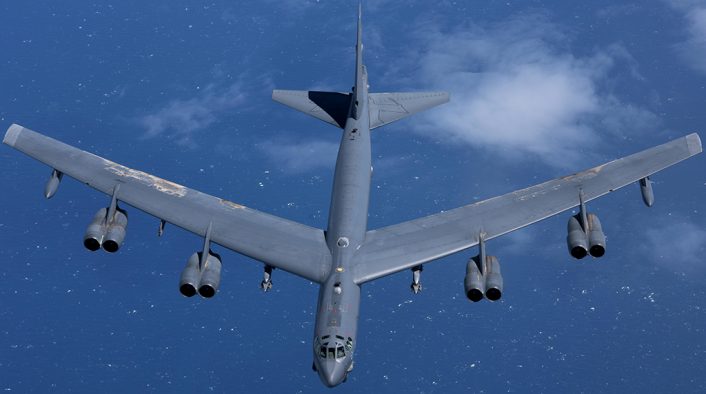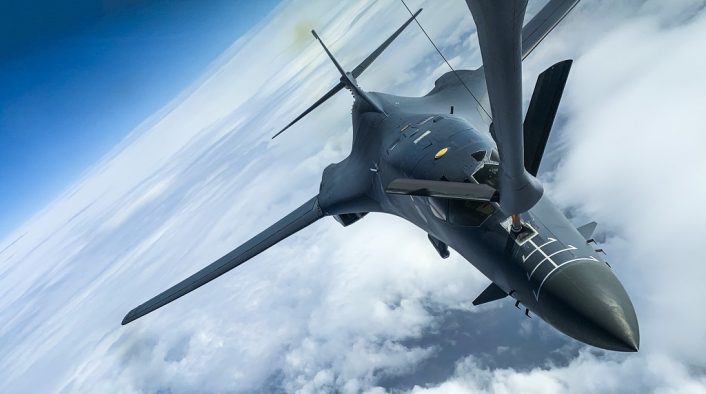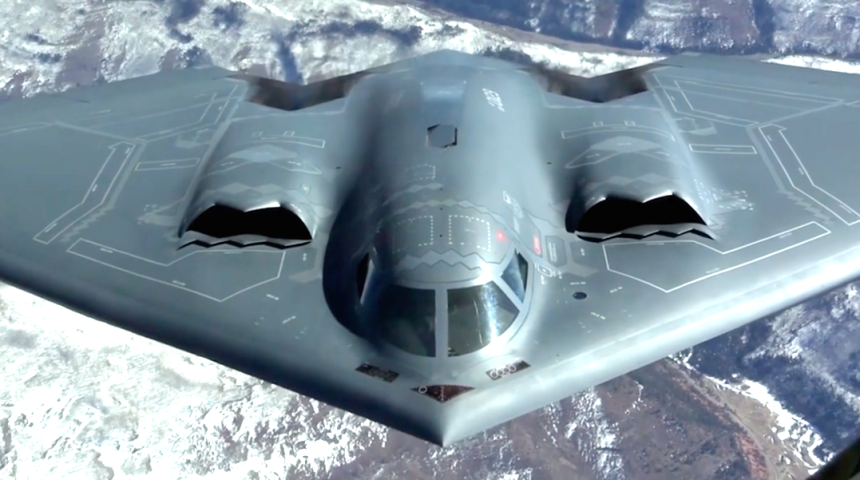vASC2020 Conference Provided Interesting Details About The Current Situation Of The U.S. Bomber Force.
As you may already know, this year’s edition of the Air Force Association Air, Space & Cyber Conference was held virtually from September 14 – 16 due to the COVID-19 prevention measures. As we did last year, here is a review about the current and future situation of the U.S. Air Force bomber fleet.
Gen. Timothy M. Ray, the head of Air Force Global Strike Command, speaking at the conference said that the Air Force still needs 220 total bombers, including about 100 new B-21s, highlighting the fact that this number is not definitive and could change anytime, as it was already increased from the initial 175 bombers. The number does not appear to have changed much since last year, when the Air Force set a goal for a total of 225 bombers. In either case, the bomber force is likely to shrink below the actual 156 bombers before beginning to grow to reach the 220 aircraft goal, according to Maj. Gen. Mark E. Weatherington, commander of the 8th Air Force and of the Joint Global Strike Operations Center at Barksdale Air Force Base.
The ability to meet is closely related to the B-21 Raider development, as the Air Force is making sure that the aircraft will be affordable, sustainable and rapidly modifiable/upgradeable, the B-1B readiness, which need to keep improving like it did this year, the B-52H engine replacement program, which needs to stay on track, and the B-2A fleet deterioration, which needs to stay at a minimum level until there are enough B-21s available to begin the Spirit’s retirement.
Even with the B-21 arrival, the older bombers will still be relevant thanks to hypersonic weapons that will add a new stand-off capability to the B-1 and the B-52, with the latter continue to serve alongside the B-21 through 2050. The new weapons and the Raider will also increase the complexity of the bomber force, which will increase from 20% low-observable aircraft to two-thirds low-observable, according to Maj. Gen. Weatherington, thus forcing the Air Force to spread the fleet on multiple bases, instead of basing all the B-21 at Whiteman Air Force Base like the B-2 Spirit, and changing the way the bomber force is organized and operates.
Meanwhile, the readiness rates of the current bomber fleet are constantly improving, as the bomber fleet shifted away from continuous deployment abroad and close air support missions, focusing instead on the dynamic force employment with Bomber Task Force missions in Europe and in the Pacific. Thanks to this concept, of 76 total B-52s in the fleet, 30 are available anytime for combat missions, while the B-2 has an even higher readiness rate with 18 out of 20 aircraft available anytime, according to Gen. Ray.
B-52H Stratofortress
As was said also during last year’s conference, the B-52 is undergoing some major upgrades to meet the demands of future combat scenarios it may encounter, mainly new engines, radar, weapons, and connectivity.
Back in May, the Air Force released a request for proposals for the B-52 Commercial Engine Replacement Program to General Electric, Rolls-Royce, and Pratt & Whitney, with a contract award projected for June 2021. As we anticipated last year, GE is proposing the CF34-10 and the Passport engines (used by the Embraer E190/E195 airliner and the Bombardier Global 7000/8000 business jet respectively), RR is planning to offer the F130 (military version of the BR725 used by the Gulfstream G650 business jet and already powering both the C-37 and E-11 BACN), PW is offering the PW800 (initially designed for regional and business jets).
According to Maj. Gen. Weatherington the Air Force assessed that between 30 to 40 airframes could get the new engine every year, completing the upgrade program in about three years instead of the ten initially planned.
As for the radar, there are no updates about the status of the program. All we know is that Raytheon is developing the new radar using technology from the F-15C’s APG-63, F-15E’s APG-82 and the F/A-18E/F’s APG-79 AESA radars.

The weapons upgrades comprise mainly new hypersonic and cruise missiles and an improved Conventional Rotary Launcher for the bomber’s weapon bay that could provide a total internal weapon carriage capacity in the entire fleet “equivalent of 20 additional bombers”, while allowing also the internal carriage of guided weapons that were previously only carriable externally, increasing the smart weapon carrying capacity by 67%.
While there are currently no plans for the integration of the GBU-39/B Small Diameter Bomb on the bombers, Boeing envisioned a further increase of the weapon carriage capacity in a rendering published in the company’s virtual showroom, created for the vASC2020 conference, which showed the B-52 carrying 128 SDBs, of which 32 carried internally and 96 under the external pylons.
Regarding the connectivity, Boeing delivered last month the last kit for the Combat Network Communications Technology (CONECT) upgrade, a communications modification acting as a framework that allows aircrew to receive intelligence, data and voice messages from multiple sources, giving to the B-52H 21st-century situational awareness along with improved mission flexibility.
Apart from the upgrades, the B-52 fleet is reported to be in very good health, with a 100% mission ready crew status on almost a regular basis.
B-1B Lancer
As mentioned last year, during the last few years the B-1B fleet was plagued by problems of various nature, causing a drop of the readiness rates to just over 50%. Gen. Ray, during this year’s conference, said that the recovery has been “incredibly successful” and even six or seven months ahead of the expected timing, with over 20 out of 62 B-1s available anytime for operational missions, after reaching the lowest availability with just six aircraft in 2019.
This was done by returning in the United States all the B-1s that were deployed in the CENTCOM area, freeing the bomber from the heavy workload of the Close Air Support, a mission it wasn’t really designed for and which caused an increased amount of wear. Because of this, the Air Force is planning to retire 17 of the most structurally fatigued aircraft to better manage the resources.

Another consequence of the increased wear of the fleet arrived this year with the imposition of a yearly limit of 300 flight hours for each aircraft, with a ban also for low-level terrain-following flight training. Also this year, the 76th Aircraft Maintenance Group at Tinker Air Force Base stood up a dedicated repair line just to repair B-1 structural issues that, together with the repair works that addressed numerous structural issues to make the fleet healthy again, will contribute to keep the bomber in service with the Air Force until 2040.
No other upgrades have been disclosed, other than the internal bay capacity increase and the return of external hardpoints that were deactivated following arms treaties with Russia, as announced last year. Similarly to the B-52, Boeing showed a rendering also for the B-1B, with a total of 144 SDBs, of which 96 in the bomb bays and under the external pylons. Boeing actually stated in a video that the “Bone” could execute a single pass “carpet bombing” dropping all the 96 SDBs from the bomb bays in just 41.2 seconds.
B-2A Spirit
Oddly enough, there were no particular updates of the B-2A Spirit fleet’s situation during this year’s conference, other than the aircraft availability that we mentioned earlier.
B2 and B21
19 Sept 2016, B-21 formally named “Raider” in honor of Doolittle Raiders.
expected to enter service by 2025 and complement existing Rockwell B-1 Lancer, Northrop Grumman B-2 Spirit, Boeing B-52 bomber fleets in U.S. service and eventually replace these bombers pic.twitter.com/O8lVeahghF
— Chris Bolton (@CcibChris) March 22, 2020
B-21A Raider
About the B-21, Maj. Gen. Weatherington said that the first bomber, currently under construction, will fly no earlier than 2022, instead of the late 2021 estimate made last year. Even with this slight delay, the bomber is reported on track and on schedule and even with a reduced unit cost than previously predicted.
This is also contributing to the Air Force considering an acceleration of the acquisition program, buying more aircraft every year and allowing a quicker retirement of the B-1B and the B-2A, in an effort to reduce logistics and training issues and increasing the bomber fleet’s efficiency as the new bomber comes online.
“Arsenal plane”
While the priority is the bomber force modernization and sustainment to stay on track with the bomber roadmap until the B-21 is accepted in service, Gen. Ray said that the “Arsenal Plane” is being discussed by the Pentagon. A more concrete discussion about this capability is expected in the late 2020s, when the bomber fleet could begin its growth to 220 aircraft.
The General also stated previously that the B-52, as it stands, is already an excellent “Arsenal Plane”. The same concept was acknowledged by Maj. Gen. Weatherington, who stated that there are also two ideas recently getting attention which envision a commercial airliner adapted as a cruise missile carrier and cargo aircraft carrying “palletized munitions.”
The latter idea should be also strictly dependent on how much excess airlift capacity is available to the Air Force and then weigh that against strategies requiring short notice deployments with heavy movement of people, vehicles, and equipment, much like we saw in January with the continuous airlift flights to the Middle East used to rapidly deploy troops following the Attack on the US Embassy In Iraq.
The Arsenal Plane, aka Arsenal Aircraft, is less efficient than long-range subsonic bomber (B-2?) beyond a range to target of about 1,000 n.m., the CBO concluded in 2006.
But AP/AA is always more efficient than a medium-range subsonic bomber (B-21?).https://t.co/O6KYHZiwbj pic.twitter.com/AbKAl5D0iB
— Steve Trimble (@TheDEWLine) May 29, 2020
A proof-of-concept test was conducted by the Air Mobility Command during the recent Advanced Battle Management System evaluations, where C-17s tested dropping Joint Direct Attack Munitions (JDAM). Gen. Jacqueline D. Van Ovost, head of AMC, said about the test: “This concept, once fully mature, is for the munitions to behave just as if they were dropped from a bomber aircraft. They separate from the airplane, they ignite their motors, fly to pre-designated waypoints using different flight altitudes, and then they strike their targets. Our Airmen are hard at work, further developing this concept, but it was a powerful demonstration of how mobility forces can be used in non-traditional ways. […] We haven’t really looked at the full concept to see how many it would take, and this is not taking the place of any of the Global Strike capabilities. This is just the capability we want to have, should we need it, and if we pull it into an [operations] plan, that’s great.”
The JDAM pallet system is undergoing a second phase of additional testing, with a third phase reportedly featuring a missile launch. This new capability, however, will require additional training for the aircrews and targeting systems aboard the C-17.
Hypersonics
One of the most recent capabilities that are gathering a lot of interest is the AGM-183 Air-launched Rapid Response Weapon (ARRW) hypersonic weapon that could be a temporary measure until more advanced types come along, according to Maj. Gen. Weatherington.
The Air Force is currently looking to obtain a range of capabilities in hypersonics, with a range of weapons in different size categories. As a matter of fact, the service is looking both at a larger weapon with greater range to be carried by the bombers and a smaller one with less range or payload to be carried by fighter aircraft too. An example of this was seen in the F-15EX’s renderings which featured a hypersonic missile under the fuselage’s center pylon.
Learn more about scramjets, and how we’re advancing hypersonic propulsion by visiting our #vASC2020 booth here: https://t.co/EwWrG5Ufdx@AirForceAssoc pic.twitter.com/5M6ryKwq89
— Aerojet Rocketdyne (@AerojetRdyne) September 15, 2020
Another range of weapons will be available by using both boost-glide missiles, like the ARRW, and air-breathing missiles, like the new Expendable Hypersonic Air-Breathing Multi-Mission Demonstrator Program or “Mayhem” that is being developed, with the Air Force soliciting concepts for a preliminary design from Boeing, Lockheed Martin’s Skunkworks, and Raytheon, all with hypersonic and scramjet propulsion experience, and expecting a contract award in early 2021. Even of Mayhem is expected to be larger than ARRW, the missile is planned to be carried also by fighter aircraft.
The introduction in service of hypersonic missiles in the next years will increase the firepower of the B-52, the first scheduled to receive the new weapons, and the B-1. Gen. Ray stated that the AGM-183 ARRW should be integrated on the B-1 as soon as possible, as the bomber is expected to perform excellently in the standoff role with the weapons carried on the external pylons.
Long Range Stand Off weapon
The Long Range Stand Off (LRSO) weapon, which will replace the AGM-86B Air-Launched Cruise Missile, has been often attacked by lawmakers believing that a cruise missile with either conventional or nuclear warheads would be destabilizing and could unnecessarily raise the risk of a nuclear war. The Air Force however argued that a nuclear missile that can be fired from standoff distances is needed for the B-52 to remain a credible deterrent against adversaries with advanced air defense systems, adding that while adversaries are also developing cruise and ballistic missiles, the LRSO is not escalatory.
Back in April, the Air Force selected Raytheon as the prime contractor for the program, two years ahead of schedule. In 2022 a contract is scheduled to be awarded for the next phase of the program. The Air Force and Congress have also been discussing potential acquisition of conventionally armed variants of the missile, and in fact the missile has been reserved two designations for the first prototypes, YAGM-180A and YAGM-181A.
However, at least for this year, the Congress repealed the requirement for a conventional warhead version of the LRSO, with the Air Force now looking to the AGM-158B JASSM-ER (Joint Air-to-Surface Standoff Missile-Extended Range) and the AGM-158D JASSM-XR (JASSM-Extreme Range) to fill the requirement for a conventional air-launched cruise missile.
US, Japan bomber-fighter integration demonstrates dynamic force employment. https://t.co/rINdeoEZT7
— U.S. Forces Japan (@USForcesJapan) April 23, 2020
Dynamic Force Employment
Since April, the Air Force moved away from the permanent Continuous Bomber Presence mission in the Pacific, with the bombers deployed at Andersen Air Force Base (Guam), and instead adopted a “Dynamic Force Employment” model, sending Bomber Task Forces flying directly from the continental United States on long-distance missions or short duration deployments at Andersen, similarly to the BTF missions happening already for some time in Europe with deployments to RAF Fairford (UK).
The Dynamic Force Employment, together with the Agile Combat Employment already tested with fighter aircraft, is meant to deny the adversaries from building a good situational awareness of the U.S. forces, especially regarding where they are, their activities, their operational range and their point of origin for operational long range missions.
According to Gen. Ray, the new employment model contributed to improve the bomber force’s readiness, while also allowing the US to flexibly respond to demands for power projection anywhere on the planet. The General also said that hypersonic munitions will only enhance that capability and that these weapons are incredibly valuable to combatant commanders.










